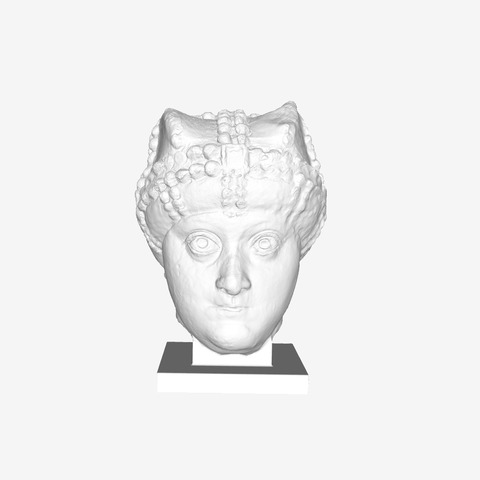
The Empress Ariane at The Louvre, Paris
cults3d
We are aware of two other portraits carved of this woman of high rank (one in Rome, the Palace of the Conservatives and St. John Lateran), identified most often as the Empress Ariadne (474-515) but also believed to be Licenia Eudoxia, the wife of Valentinian III, or Amalasuntha, the daughter of Theodoric the Great, king of the Goths.\n\nThe Empress Ariane was known as the queen of Constantinople. This city was reinaugurated in 324 AD at ancient Byzantium, as the new capital of the Roman Empire by Emperor Constantine the Great, after whom it was named, and dedicated on May 11, 330. By the 12th century, the city had become the largest and wealthiest European city, playing a key role in the advancement of Christianity during Roman and Byzantine times. After losing its territory, the Eastern Roman (Byzantine) Empire was reduced to just its capital city and its surroundings, eventually falling to the Ottomans in 1453. Following the Muslim conquest, the former bastion of Christianity in the east, Constantinople, was turned into the capital of the Ottoman Empire, under which it prospered and flourished once again. For many centuries, the city was popularly known as "Istanbul", from a Greek phrase meaning "to the city", while officially it was known by various names, including Constantinople and Dersaadet. Other names than "Istanbul" became obsolete in late Ottoman Empire, and after Turkey switched to Latin script in 1928, it began urging other countries to use the Turkish name, and "Istanbul" gradually gained international usage.\n\nConstantinople was renowned for its massive defenses. Although besieged on numerous occasions by various peoples, the Byzantine city was taken only in 1204 by the Latin army of the Fourth Crusade, recovered in 1261 by the Byzantine Emperor Michael VIII Palaiologos, and in 1453 conquered by the Ottoman Sultan Mehmed II. The first, smaller wall was erected by Constantine I, surrounding the city. Later, in the 5th century,Theodosius II constructed the Theodosian Walls, consisting of a double wall lying about 2 kilometers to the west of the first wall. The city was built on seven hills as well as on the Golden Horn and the Sea of Marmara, presenting an impregnable fortress enclosing magnificent palaces, domes, and towers spanning two continents.\n\nThe city was also famous for its architectural masterpieces, such as the Greek Orthodox cathedral of Hagia Sophia which served as the seat of the Ecumenical Patriarchate, the sacred Imperial Palace where Emperors lived, the Galata Tower, the Hippodrome, and the Golden Gate, lining arcaded avenues and squares. Constantinople contained numerous artistic and literary treasures before it was sacked in 1204 and 1453. The city was virtually depopulated when it fell to the Ottoman Turks, but recovered rapidly, and by the mid-1600s, once again became the world's largest city as the new capital of the Ottoman Empire.
With this file you will be able to print The Empress Ariane at The Louvre, Paris with your 3D printer. Click on the button and save the file on your computer to work, edit or customize your design. You can also find more 3D designs for printers on The Empress Ariane at The Louvre, Paris.
